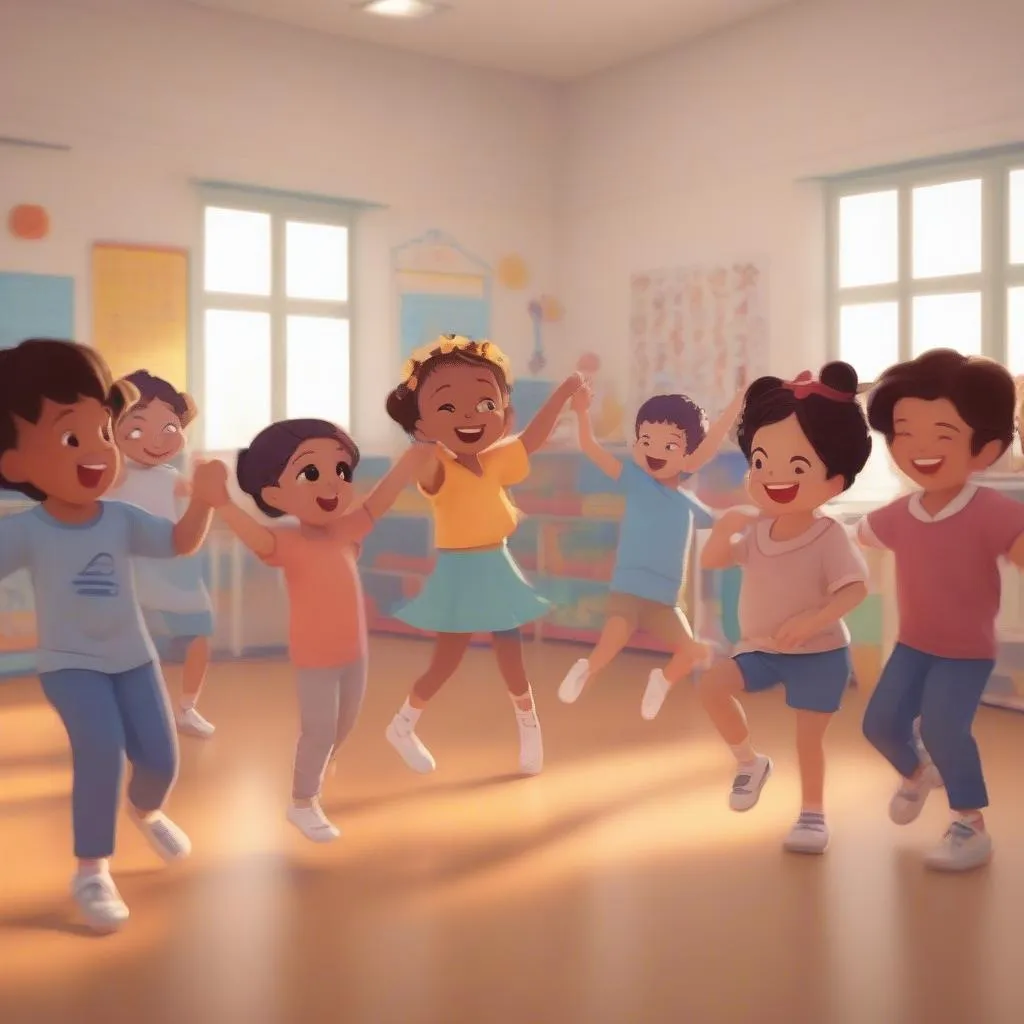“Practice makes perfect” – the old proverb teaches us the value of mastering a skill to proficiency. And when it comes to early childhood education, dance is a wonderful “weapon” to comprehensively develop children. More than just a recreational activity, dance helps children train physically, develop creativity, musicality, and communication skills. So, how to choose suitable and engaging dances for preschoolers? Let’s explore the secrets in this article with TUỔI THƠ!
Preschool Dance: A Journey to Explore a Magical World
Is your child a big fan of fun dances? Or whenever they hear music, do they like to sway along? If so, you have the “key” in hand to help your little one develop comprehensively and become more confident. Dance is a very beneficial activity for preschoolers, bringing many advantages to their development.
Golden Benefits of Dance for Preschoolers
 Preschool Dance – Child's Joyful Expression
Preschool Dance – Child's Joyful Expression
- Physical training: Dance movements help children increase flexibility, agility, and rhythmic coordination between hands, feet, eyes, and body. This supports comprehensive physical development for children.
- Creativity development: Dance is a “playground” for children’s imagination. Children are free to express themselves through body language, create movements, expressions, and their own style.
- Musicality: Dance helps children train their musicality, learn to distinguish melodies, rhythms, and music genres. Children also learn to coordinate movements with the rhythm of the song.
- Communication skills: Team dance helps children learn to coordinate with friends, train confidence, effective communication, and teamwork skills.
- Boosting confidence: When children confidently express themselves on stage, they will be more confident in other activities, such as communication, learning, and playing.
Tips for Choosing Dances for Preschoolers
“Choose friends to play with, choose books to read,” choosing dances for children also needs to pay attention to important factors.
- Child’s age: Choose dances that are appropriate for the child’s motor skills, concentration, and ability to absorb.
- Child’s interests: Listen to the child’s opinions, find out which dances they like to create excitement for them to participate.
- Dance content: Choose dances with simple, easy-to-understand content, suitable for the child’s psychology and age.
- Music: Choose fun, cute, easy-to-remember songs with melodies suitable for the style of the dance.
- Costumes: Choose costumes that match the theme and style of the dance, helping children feel comfortable and confident to express themselves.
Suggestions for Engaging Dances for Preschoolers
By theme:
- Animal dances: “Little Chicken,” “Little Mouse,” “Little Elephant” are cute dances that help children learn about the animal world.
- Nature dances: “Cool Banyan Tree,” “Blooming Rose,” “White Clouds Flying” bring children lessons about nature and the environment.
- Family dances: “Parents Love Children,” “Happy Family,” “Grandparents” are dances that help children love and be closer to their family.
- Festival dances: “Lion Dance,” “Dragon Dance,” “Flower Dance” bring children the bustling and joyful atmosphere of traditional festivals.
By style:
- Folk dances: “Dragon Dance,” “Lion Dance,” “Umbrella Dance” help children access the traditional culture of the nation.
- Modern dances: “Hip Hop,” “K-Pop,” “Pop Dance” help children be active, creative, and express their personality.
- Classical dances: “Swan Lake,” “Romeo and Juliet,” “Don Quixote” help children access classical dance art, train elegance and poise.
Frequently Asked Questions About Dance for Preschoolers
Q: My child is still young and doesn’t know how to dance. Should I let them learn to dance early?
A: According to preschool education expert Nguyen Thi Thu Ha: “Learning to dance from a young age will help children develop comprehensively, creating a solid foundation for physical and mental development.” Exposing children to music and dance from an early age helps them develop motor skills, musicality, and enhance confidence and effective communication.
Q: Where should I let my child learn to dance?
A: You can let your child learn to dance at preschool education centers, professional dance classes, or find home dance teachers.
Q: How to make children love learning to dance?
A: Create a fun, comfortable atmosphere, encourage children to participate, praise them when they make progress, and motivate them with small rewards.
Q: My child has no talent for dancing. Should I force them to learn to dance?
A: Dance is an art form that requires love and passion. Instead of forcing, create conditions for children to approach dance naturally, sparking their love and interest. If your child is not interested, respect their preferences and guide them to other suitable activities.
Conclusion:
“Dance” is not just a dance, but a journey to explore a magical world, helping children develop comprehensively and become more confident. Create conditions for your little ones to experience engaging dances, practice skills, and bring joy to their childhood. If you need more information or want to learn about dances suitable for your child, please contact TUỔI THƠ via Phone Number: 0372999999, or visit the address: 234 Hao Nam, Hanoi. We have a 24/7 customer care team, always ready to assist you!